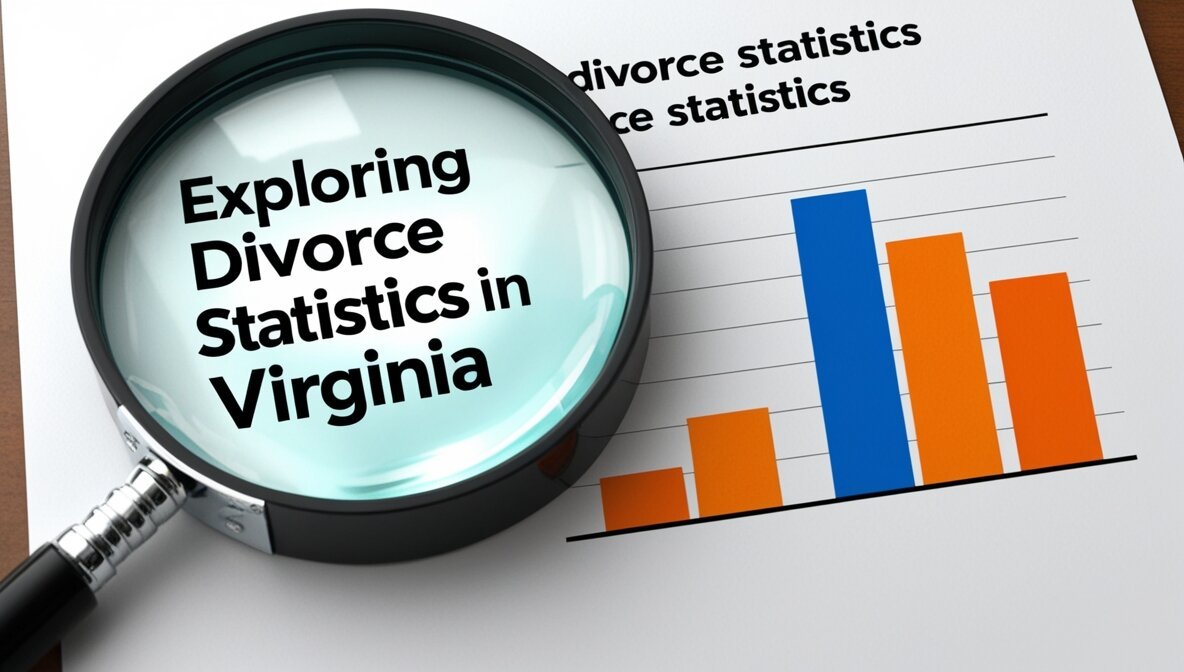Divorce is a significant event with wide-reaching implications, and understanding the statistics behind divorce in Virginia provides insights into the state’s social, economic, and family dynamics.
This article explores divorce trends and patterns to provide a comprehensive understanding of how divorce affects Virginia families, considering data from sources like the U.S. Census Bureau and (ACS) the American Community Survey.
The goal is to shed light on the primary influences driving divorce rates and support families experiencing this change.
Overview of Divorce in Virginia
In Virginia, divorce laws aim to create fair, systematic procedures for marital dissolution. Residency requirements mandate that at least one spouse has lived in the state for six months before filing.
Divorce can be fault-based (due to adultery, abandonment, cruelty) or no-fault, where irreconcilable differences are cited without assigning blame.
In fault-based divorces, one spouse is held accountable, which may influence the division of assets or spousal support. No-fault divorce has gained popularity as it reduces conflict and simplifies proceedings. Virginia also recognizes legal separation, where couples live apart but remain legally married.
Key Divorce Statistics for Virginia in 2024
Recent data from the U.S. Census Bureau and Statista highlight current divorce trends in Virginia, showing state-specific divorce rates against the national average.
In 2024, divorce rates in Virginia show slight declines, consistent with broader U.S. trends. Divorce is most common among individuals aged 30-55, with high rates among those in their second or third marriages.
Divorce Rate Comparisons
Virginia’s divorce rate varies by region and economic factors. Urban areas like Northern Virginia have lower divorce rates compared to Richmond and Virginia Beach, possibly due to higher income and education levels.
Economic disparities play a role: regions with limited employment opportunities and lower income levels see higher divorce rates, mirroring national trends observed by LegalZoom.
On a national scale, Virginia ranks in the lower half for divorce rates, showing resilience compared to states with traditionally high rates like Nevada and Oklahoma.
Internationally, the U.S. has a higher divorce rate than European countries, though Virginia aligns closer to the national median.
Trends and Influences on Divorce Rates
Historically, divorce rates in the U.S. rose through the 1970s and 1980s, driven by changing social norms and the acceptance of no-fault divorce laws.
Virginia reflects this trend, with crude divorce rates (measured per 1,000 people) and refined divorce rates (per 1,000 married women) showing slight decreases in recent years.
This shift aligns with greater societal emphasis on marital counseling and increased access to support services.
Common Reasons for Divorce in Virginia
Divorce is a significant issue that affects many families in Virginia. Understanding the common reasons for divorce can help us grasp the broader implications of these separations. Leading causes include communication issues, financial stress, and incompatibility.
Communication issues often stem from a lack of effective dialogue between partners. Couples may find it challenging to express their feelings, leading to misunderstandings and resentment.
Additionally, financial stress plays a crucial role. Money problems can create significant tension, often resulting from job loss, excessive debt, or differing spending habits.
Incompatibility is another primary reason for divorce. Couples may grow apart over time or discover fundamental differences in values and life goals. Other factors such as infidelity, lack of intimacy, domestic violence, and substance abuse can also lead to a breakdown in marriage.
Research indicates that about 50% of marriages in the United States end in divorce, and many of these separations can be traced back to these key issues. As these reasons contribute to current divorce trends, addressing them may help mitigate the impact of divorce on families.
Divorce Rates by Demographics
Divorce rates vary significantly across different demographics in Virginia. Analyzing the data reveals how factors like age, gender, and race affect these rates.
For instance, younger couples, especially those aged 20-30, tend to experience higher divorce rates compared to older age groups. Women generally file for divorce more often than men, indicating potential differences in how each gender perceives marital satisfaction.
Race also plays a role in divorce rates. Different cultural backgrounds may influence marriage dynamics, leading to varying stability levels.
Furthermore, income and education levels impact divorce rates. Individuals with higher education, such as those with college degrees, often have lower divorce rates. This trend suggests that socioeconomic status can affect marital stability.
Additionally, religion and occupation are notable factors. Religious beliefs may discourage divorce, while certain professions may expose individuals to stressors that impact marital satisfaction.
A comprehensive understanding of marriage and divorce rates within Virginia can provide insight into these demographic trends, helping to paint a clearer picture of the challenges couples face.
Impact of Divorce on Families in Virginia
The consequences of divorce extend beyond the couple, deeply affecting families, especially children. Financial implications are one of the most immediate challenges. Divorced individuals often experience reduced household income, which can lead to a struggle for basic necessities.
Child custody issues can complicate the financial landscape further. Determining custody arrangements can be contentious, impacting children’s emotional well-being. For instance, research shows that children in joint custody arrangements tend to fare better than those in sole custody situations.
To support families in this transition, various support services are available in Virginia. Family counseling can help individuals navigate the emotional fallout of divorce, while legal assistance can provide guidance through the complexities of custody agreements and financial settlements.
Additionally, community resources play a vital role. Support groups for divorced individuals can offer a safe space for sharing experiences and coping strategies, reinforcing the idea that no one is alone during this challenging time.
Related Statistics and Resources
Understanding divorce statistics requires access to reliable data sources. The American Community Survey (ACS) is a primary source for marriage and divorce statistics in the United States, providing insights into demographic trends.
In Virginia, the ACS indicates various trends in marriage and divorce rates, allowing for a deeper analysis of the factors contributing to these changes. Other research reports and community resources complement this data, offering further context.
For those affected by divorce, numerous resources are available. Legal aid organizations can help individuals navigate the legal aspects of divorce, while family counseling services provide emotional support. Additionally, support groups can offer a sense of community for those going through similar experiences.
By utilizing these resources, families can find the support they need during challenging times, helping to mitigate the impact of divorce on their lives.
Conclusion
In summary, understanding the trends and statistics surrounding divorce in Virginia is essential for supporting families effectively. From the common reasons for divorce, such as communication issues and financial stress, to the demographic factors influencing these rates, each aspect provides valuable insights.
Recognizing the impact of divorce on families, especially regarding financial implications and child custody, emphasizes the need for adequate support services. By tapping into resources like the American Community Survey and community support programs, families can navigate the complexities of divorce more effectively.
As we continue to explore these trends, it is crucial to focus on providing support for families affected by divorce. By understanding the statistics and their implications, we can work towards creating a more supportive environment for those facing this significant life change.








